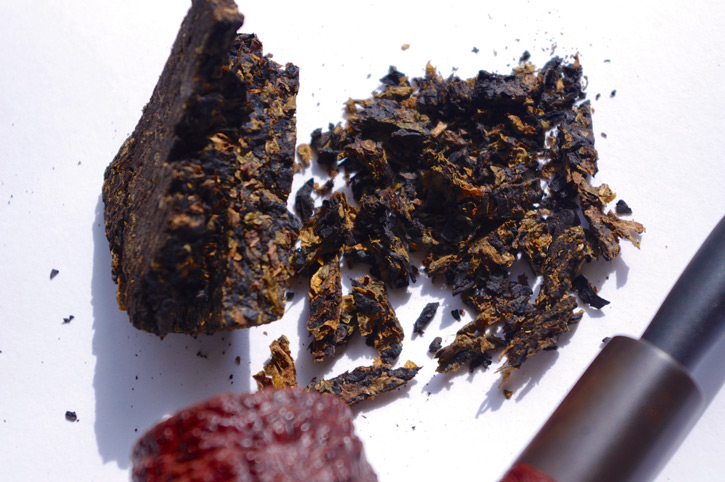E. Roberts
 "We are pleased to announce that the Board of Directors of The Standard Tobacco Company of Pennsylvania, today at 9:30 am executed the instrument conveying to Meier & Dutch the right to manufacture and distribute, under Standard Tobacco’s trademarks, War Horse, John Cotton’s blends, and Bengal Slices." This post, which appeared on several pipe forums this past 10th July, ushered in a new chapter detailing the continued resurgence of the pipe smoker in popular culture. The story of Standard’s inchoation embodies the story of the revived interest in this pastime we share that bridges generations and carries a collective history. To tell the story of Standard Tobacco is to tell the story of the tobacco hobby today.
"We are pleased to announce that the Board of Directors of The Standard Tobacco Company of Pennsylvania, today at 9:30 am executed the instrument conveying to Meier & Dutch the right to manufacture and distribute, under Standard Tobacco’s trademarks, War Horse, John Cotton’s blends, and Bengal Slices." This post, which appeared on several pipe forums this past 10th July, ushered in a new chapter detailing the continued resurgence of the pipe smoker in popular culture. The story of Standard’s inchoation embodies the story of the revived interest in this pastime we share that bridges generations and carries a collective history. To tell the story of Standard Tobacco is to tell the story of the tobacco hobby today.
When Dan, Simon, and Roger gathered over sushi and pipes last autumn, they did not intend to embark on the creation of a company to resurrect long-dead trademarks of venerated British blends. But that’s exactly what happened, purportedly after a few too many carafes of hot sake. The formation of the Standard Tobacco Company is a journey that began with idle conversation, a laugh and a "what if…?"; eventually that led to acquiring abandoned trademarks, ferreting out lost recipes, a CSI-worthy investigation of vintage tins—including advanced chemical analyses—and, perhaps most importantly, interviews with folks whose memories held the secrets of these erstwhile tobaccos. It’s a given that we pipe smokers are the quietly passionate sort. That three friends’ idle pondering can become a pet project pursued to such fruition is also testament to how accessible is our tiny little niche of the industry.

Taste lies in our most primitive brain; our very survival depends on taste recognition. Taste and smell have a direct line to our deepest subconscious faculties, and as such are able to make some of the strongest impressions on our memory, on our consciousness. The neurobiology of taste perception and memory cognition is a deep, deep sea that we stand at the shore of, with only a notion of its vastness. And though taste may summon memory, it is context that characterizes the Proustian experience. Who can forget the taste of their wedding cake, or the aseptic air of the hospital room where their child was born? And are the quiet, quotidian moments any less impactful? Though time may cloud this imperfect lens, it is ultimately memory that paints a more accurate and viable impression of an experience than dry chemical analysis or gas chromatography–mass spectrometry alone could convey.

Master Blender Russ Ouellette
To have the hubris to reanimate a slumbering legend takes moxie as well as memory. Russ Ouellette is a man possessed of both. In his own words,
This was probably the most daunting project I’ve ever undertaken. It’s one thing to do a "tribute" blend, but to reconstruct blends that will bear the actual name of the original products is a whole different kettle of fish. Luckily, I had smoked all of these blends fairly frequently during the seventies, so I had clear memories of those tobaccos, with the exception of War Horse. I knew what tobaccos were in the blends, but I didn’t know the proportions or the source of the leaf, and that’s where the creative process begins.
For a man whose resume reads like a tobacco encyclopedia, this is no false modesty. Fundamentally, he was aiming to rekindle the experience of the tobaccos; to infuse the ephemeral and intangible qualities that far exceed percentages of leaf. To target the heart of the blends, he reached deeply into his own personal memories and those whom he interviewed. Russ summarizes, "In spite of the research and detailed analysis, at the end of the day, for me it’s all about memory and understanding what each component will do for a blend." As past projects have shown—Black House being the most renowned, alongside White Knight, both Sobranie homages; or Mel Feldman’s The Smoker blends, to name just a couple—the man is something of a tobacco wunderkind with a talent for conjuring recipes that evoke the ghosts of pipes long past. With the help of spreadsheets, copious tasting notes, interviews with colleagues and friends who’d smoked the originals, and no small amount of scientific inquiry, he set to work codifying the new recipes, and the results are fantastic.
These first impressions are based on the final pre-production samples, approximately 24 grams of each—just enough to get a good feel for them, just enough to leave me wanting more.


John Cotton’s Nos. 1 & 2 Medium
This one is somewhat of a sleeper hit for me; at first nonplussed, I’ve been returning to it over and over again since. A beautifully variegated ribbon mixture, it’s mild enough to repeat bowls with, yet also contains enough complexity to really showcase the interplay of ingredients. Its one downfall is that it’s a little dull on the aftertaste—it needs some tin time, and moisture, for the tobaccos to marry together, in my opinion. By his own account, this is the blend Russ smoked most frequently back when it was produced in the seventies, and his experience with judging the entrants for the 2012 John Cotton Throwdown certainly didn’t hurt. The smoke benefits from a sweet beverage to accompany it, as it accentuates the cola, cinnamon, and honeysuckle notes.

John Cotton’s No. 1 Mild
A very Virginia-leaning English blend, it solidly benefits from larger bowl to release its tannic overtones, highlighting the hide glue & parchment body. It actually comes across much more medium than mild, in a very good way. The Oriental component is used to perfection, lightly spicing the mixture with a subtlety that lends it a great deal of grace with its sour floral flair. Worthy of all-day smoking—or all night, as is the case while I write this piece.

John Cotton’s Smyrna
My favorite of the lot, with its decidedly punchy Oriental eponym. Behind the tart and tangy Virginia-Latakia nexus, it has a well-defined sweet tea with lemon feel and finely floral creaminess. I daresay it is the most complex of the offerings, building on its initial high notes in the fore with a background astringency that clings to the tongue, ending with a milk chocolaty finish. It traverses seamlessly through subtle and strong flavors, the hallmark of this Turkish varietal—a real showcase for the leaf, bold and compelling.

The soon-to-be-celebrated Bengal Slices
Back when we were formulating the New York Pipe Club blends with Russ, he mentioned some other projects he had in the works. One was a tribute to Bengal Slices, which would become Fusilier’s Ration, released in 2012. The Standard Tobacco project added a wealth of new research to the table, confirming that his initial recreation was surprisingly accurate, and allowing for some subtle refinements and improvements. Armed with this new information, the Bengal Slices redux is a true heir to the marque, and has been a favorite of many test smokers. To begin with, the presentation is a tight crumble cake that appeals visually and tactually, showing off the leaf to great effect. It breaks into briquette-like nuggets, and requires a bit of tending to reap the full reward in your bowl. But oh, the reward—a meaty, chewy smoke, with a fine Cavendish component that is very present brightening the blend. A toasted Virginia defines the structure of the smoke, its sweetness perambulating around a peaty, dried fruit tone overlaying the meaty backbone. It’s a veritable barbeque in a bowl, and stands to be the breakout hit of the bunch.

War Horse
"War Horse was simultaneously the easiest and the most difficult blend to recreate. Standard Tobacco had sent a sample to a laboratory for a detailed analysis, so I knew precisely what was in the tobacco. The problem is that some of the components are no longer available, and you should have seen the raised eyebrows when the list included things that there’s no way we would be allowed to use today …" While it may burst some folks’ bubbles to learn the blend is not an identical, to-the-letter clone of its former incarnations, they will be relieved to learn they won’t be ingesting a belladonna cocktail. Russ continues, "One of the people who tried it mentioned that the original had no Perique in it, and I’m well aware of that, but I used it as a flavoring element to try to make up for one of the flavorings that we couldn’t use." Again, he is reproducing the smoking experience rather than the rote composition, and that is ultimately a goal that will be tallied by public opinion. All its history aside, it’s a devil of a blend, with a deep dark earthiness to it that is unlike most American blends. The aroma in the bag is of dark, bitter chocolate, more on the side of burnt raw cacao seeds—and yes, I’ve had them, in Martinique during my café days. The uniformly mahogany-colored ribbon presents some undertones of herbal sweetness in the front of the bowl, giving way to the coarser fare of a stout English mix, hints of Perique and perhaps dark-fired exerting their muscle further in. Initially a loose cut, they plan to return to the bar presentation when the equipment is sorted for production. While it did not kick like a mule, its strength was on par with a cigar several times its weight in leaf; the pressed incarnation promises to amp up the intensity by an order of magnitude, hopefully satisfying the thrill seekers out there.

It’s a point of endless fascination that our anachronistic little hobby has such real-time connection to the past. In the end, though, the moral of the story will be told in the tobaccos. We must remember that all blends change, much more frequently than stalwarts would ever admit—supplies of constituent ingredients, manufacturing processes, changes in blending houses or even the guy on that shift, tin to tin, year to year—and that no, these will not be same as the ones that were made when they went out of production. But then, those blends were different from the ones a year, five years, ten years, or several decades antecedent. What these blends are, and what they have already accomplished, is to be damn good new tobaccos that we can all enjoy, and hopefully make some new memories. After the story is told, the smoke will be there to ponder.
But if they were so great to begin with, why did they stop making them? A fair enough question, and one that Dan answers most eloquently:
In a perfect world, you form a company, produce a great product, people buy it, you make money. Then the reality sets in. Financing, labor, production, distribution, marketing … all places where things can go south on you. The original John Cotton’s Co. encountered financial problems for reasons unknown to me. They sold out to Gallaher’s, whose primary business became cigarettes. As pipe smoking declined, so did their interest in their pipe tobacco line. Eventually they trimmed product and sold the whole shebang to Japan Tobacco, who had an almost zero interest in pipe tobacco. JTI in turn sold off most of the pipe stuff to Orlik. Orlik was then bought out by STG. Along the way, product managers and bean counters made decisions that got us to where we are today: A tiny company in Pennsylvania licensing back to STG brands that they once controlled. It’s a weird world, what can I say?
This time, there are no product managers. It is back to where things were 100 years ago: A small group of individuals, passionate about what they do, working to produce the best product possible, in the naïve belief that sincerity and quality are the keys to success. And so it begins … again.
Photos by E. Roberts & Dan Johnson. Opening image is one of the old expired John Cotton’s trademarks.
Read the Background Story on The Standard Tobacco Company of Pennsylvania here.


















I can’t recall a more anticipated release of blends in my 45 years of pipe smoking. I’ve also been privileged to watch the seed of this idea grow over the past year to where it is today. Yes, I will happily buy and smoke all of the new blends and, yes, they are that good.
Thanks for a very well written article. I hope others read it and appreciate the work that went into this project.
John, I have to say it again: None of this would be happening if it wasn’t for folks like you. Whether it is our friends at The Lehigh Valley Pipe Club, Christopher Morley Pipe Club or the diaspora of pipe smokers who have found a home here at PipesMagazine.com, we’ve all had a hand in making this happen. Hopefully, if the regulatory environment doesn’t change too drastically, we can keep on going.
I’ll redundantly and self-servingly add my kudos to this inspiring adventure. But I also have to tag E. Roberts: your writing is so tantalizing, scintillating, almost delicious. But this time, you have really put it together.
hp
les
Good news indeed.
I’ll be waiting for when they are available locally.
I’m looking foreword to the release with great anticipation. Here’s to wishing a great success. It seems only fitting for your efforts.
Can´t wait for Bengal Slices!
Shared this story with a group of guys at Uhles…pretty pretty exicted
E. Roberts is as good as it gets in the realm of writing about tobacco. Always a pleasure to read the results of his palate as well as his, apparently, many years of discerning smoking; in this case about a group of talented, committed smokers who have pulled off the greatest tobacco extravaganza of my smoking career.
I want them all! all of those blends, especially John Cotton Smyrna, Bengal Slices and plug Warhorse!
I smoked the war horse when I lived in north of Ireland
It came in a red pouch with a picture of a black horse printed
On it man this bacy was a real good smoke I worked on
A coal truck delivering coal and the guy that owns the The business smoked a pipe so that’s how I started smoking a pipe at 13 years of age condor and war horse great smoke not mixed separate the war horse was way stronger and much better than the condor I can still taste it yet boy oh boy can’t wait to get some of that war horse again good memories sure had me a good young bit good to hear it’s coming back
The recreation of defunct , legendary , classic tobacco blends is admirable. Even involving the Mossad’s forensic expertise. I wish this venture well. It reminds me of all the small brewers now of beer, ale, stout, etc. which has now extended to bourbon, and other whiskies. Single malt scotches have always not sold out to global corporate business practices. Good luck though as more and more people have health concerns regarding tobacco and booze even though for 99% of the people, their lives are not worth living so why an iron will to live?
I’ve determined I am a Smyrna guy, but all the blends put together by these gents are tops. Thanks to you all!